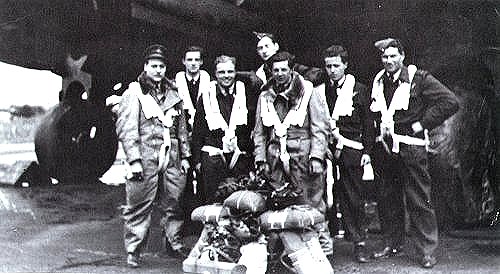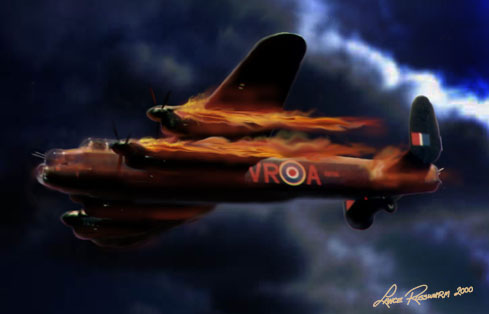The last words belong to Pat Brophy:
I'll always believe that a divine providence intervened to save me because of what I had seen, so that the world might know of a gallant man who laid down his life for a friend. Andrew Charles (Andy) Mynarski, VC, was born at Winnipeg, Manitoba, on October 14, 1916.
In 1944 he joined No. 419 Squadron, RCAF where he completed 12 operational flights and was promoted to Pilot Officer on June 11.
The following night he emplaned as mid-upper gunner of a Lancaster bomber. The aircraft never returned to base. At war's end six survivors of Mynarski's crew were liberated from German prisoner-of-war camps. The story they told led to the award of a posthumous Victoria Cross. The citation accompanying the honor tells the complete story:
"Pilot Officer Mynarski was mid-upper gunner of a Lancaster bomber, detailed to attack a target at Cambrai in France on the night of June 12, 1944. The aircraft was attacked from below and astern by an enemy fighter and ultimately came down in flames. As an immediate result of the attack, both port engines failed. Fire broke out between the mid-upper turret and the rear turret, as well as in the port wing. The flames soon became too fierce and the captain ordered the crew to abandon the aircraft.
"Pilot Officer Mynarski left his turret and went towards the escape hatch. He then saw the rear gunner was still in his turret and apparently unable to leave it. The turret was, in fact, immovable, since the hydraulic gear had been put out of action when the port engines failed, and the manual gear had been broken by the gunner in his attempt to escape.
"Without hesitation Pilot Officer Mynarski made his way through the flames in an endeavour to reach the rear turret and release the gunner. Whilst doing so, his parachute and clothing, up to his waist, were set afire. All his efforts to move the turret and free the gunner were in vain. Eventually the rear gunner clearly indicated to him that there was nothing more he could do and that he should try and save his own life. Pilot Officer Mynarski reluctantly went back through the flames to the escape hatch. There, as a last gesture to the trapped gunner, he stood at attention in his flaming clothing and saluted, before he jumped out of the aircraft. Pilot Officer Mynarski's descent was seen by French people on the ground. Both his parachute and his clothes were on fire. He was found eventually by the French, but so severly was he burned that he died from his injuries.
"The rear gunner had a miraculous escape when the aircraft crashed. He subsequently testified that had Pilot Officer Mynarski not attemped to save his comrade's life, he could have left the aircraft in safety and would, doubtless, have escaped death.
"Pilot Officer Mynarski must have been fully aware that in trying to free the gear he was almost certain to loose his life. Despite this, with outstanding courage and complete disregard for his own safety, he went to the rescue. Willingly accepting the danger, Pilot Officer Mynarski lost his life by a most conspicuous act of heroism which called for valour of the highest order."
 Crew of VR-A, L-R: Pat Brophy, Jim Kelly, Roy Vigars, Art de Breyne, Andy Mynarski, Jack Friday, Bob Bodie. I have decided to create a page dedicated to P/O Mynarski, while many of pilots stories are worthy of their own pages, A.C. Mynarski's stands out in my mind. 
|  | 419th Tactical Fighter Squadron |

